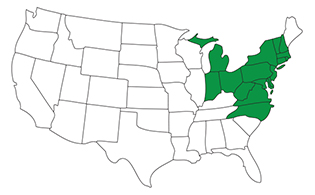
Asiatic Garden Beetle
Maladera castanea
The invasive Asiatic Garden Beetle is native to China and Japan but currently infests United States lawns in the northeastern states. This lawn pest typically feeds deep in the soil so it's not as problematic for grass as other beetles and grubs. Any damage that does occur from Asiatic Garden grubs mostly occurs during September and November.
Identify

Grubs

Sub Surface
The adult Asiatic Garden Beetle is broad, long and shaped like a wedge. You can begin to identify this lawn pest by its chestnut-brown color and velvety sheen. The adult beetle’s hind legs are distinctly larger and broader than its front or middle legs. Asiatic Garden Beetle grubs are identified by the vertical slit near the backside of the grub and a transverse (i.e., following the body's curve) row of brown spines. Although Asiatic Garden Beetles pose less of a problem for turf grass than other lawn-destroying insects (they actually eat weed roots, especially Orange Hawkweed), the animals that feed on Asiatic Garden Beetle grubs can cause damage to your lawn when digging and searching for food.
Life Cycle

Control
There are two methods for controlling Asiatic Garden Beetles that TruGreen® recommends: 1. Use professionally applied pest control designed to prevent excess lawn pest populations, which can cause damage to your lawn 2. Kill insects, grubs and other lawn pests before they have a chance to damage your lawn Proper mowing and watering techniques can also help foster a healthy lawn that's more tolerant to lawn pest attacks—plus you'll get a lawn you'll want to live on in the process.




Facebook
X
Youtube
Copy Link
Email